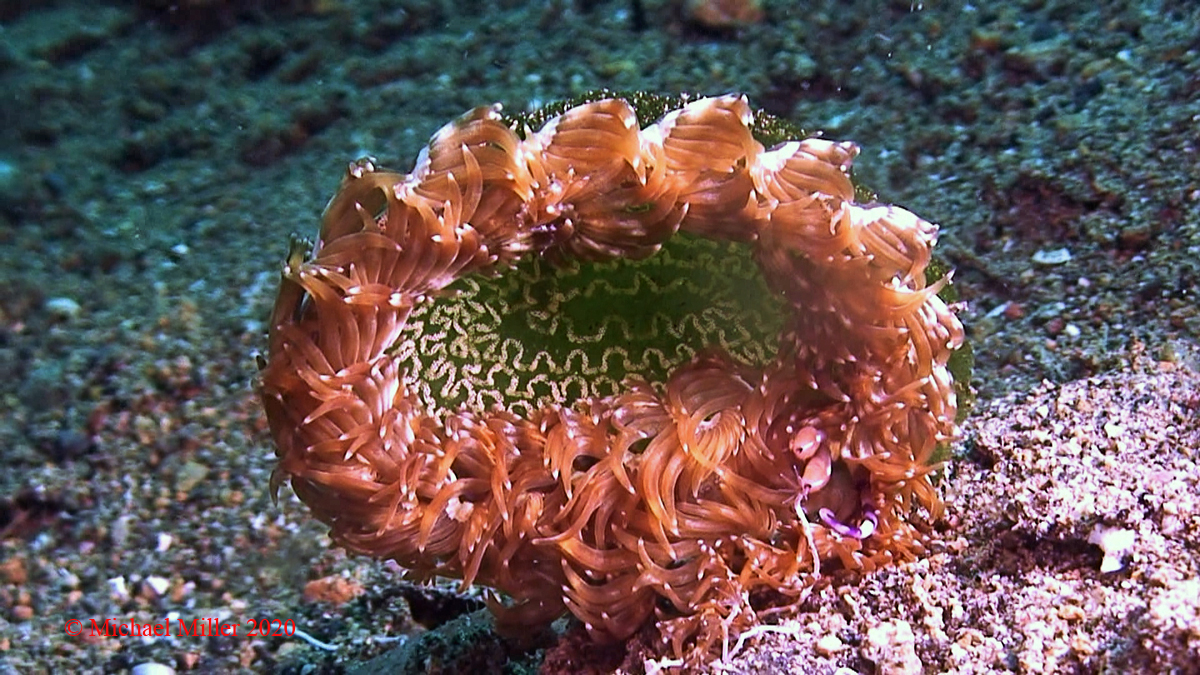 |
Pteraeolidia semperi
Image courtesy of WebmasterFreeze Frame from Video
Secret Bay Dive Site , Anilao, Philippines
Apr. 2015
For years we have called this highly variable species Pteraeolidia ianthina, but the systematic of this group was clarified by Wilson & Burghardt (2015). Commonly referred to as the Blue Dragon nudibranch because of its very long thin body and perfoliate rhinophores, its one consistent characteristic is the bright purple-blue bands on the oral tentacles.
The variation in color is due to the nutrition of the species which changes from feeding on algae as juveniles to feeding on hydroids as adults. In the latter, the adults also receive nutrition from the symbiotic zooxanthellae they acquire from the hydroids and sequester in their cerata. These zooxanthellae, continue to carry on photosynthesis, converting water and carbon dioxide into sugar and oxygen (see BOW - Placida dendritica for another solar sea slug).
One curious feature of their biology, shown here in Mike's photo, is the habit of laying their coiled undulating egg ribbon atop the green algae (Identity unknown), on shallow sunny sandy bottoms. Mike has observed this interesting behavior several times.
While P. semperii occurs throughout the tropical Indo-Pacific, P. ianthina is a temperate species.
Reference: Wilson, N.G. & Burghardt, I. 2015. Here be dragons - Phylogeography of Pteraeolidia ianthina (Angas, 1864) reveals multiple species of photosynthetic nudibranchs (Aeolidina: Nudibranchia). Zoological Journal of the Linnean Society doi:10.1111/zoj. 12266.
Sammamish, WA 98074
Apr., 2020
Send Dave email at davidwbehrens@gmail.com

Attention all you Sluggers, and you know who you are! The NSSI 2nd edition is available in ebook PDF and book form . The hard back version will become available Nov. 1st. Both will cost $65 (individually). You will need to jump through a few hoops to get the electronic version as pdf distribution is protected by Adobe ID!! Please read the following to enable reading your electronic purchase! This new 2nd Edition is updated and reorganized, including 185 new species. Among other features, the new edition includes additional photographs of species, an identification key, and an up-to-date classification reflecting the latest evolutionary relationships. The Indo-Pacific represents the largest expanse of tropical ocean in the world, stretching from the Indian Ocean coast of southern Africa and the Red Sea to the central Pacific of the Hawaiian Islands, Easter Island and the Marquesas. This region supports the most diverse marine fauna of any place in the world for most groups of marine organisms. The nudibranchs and sea slugs are no exception to this rule; there are about 3,000 described species of these organisms in the world and at least 40% of these have been found exclusively in the Indo-Pacific tropics. This book illustrates 2,138 Indo-Pacific nudibranchs and sea slugs, including many undescribed species.
|

|
